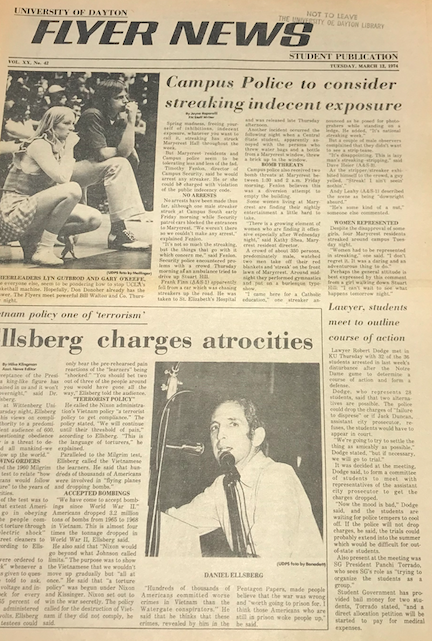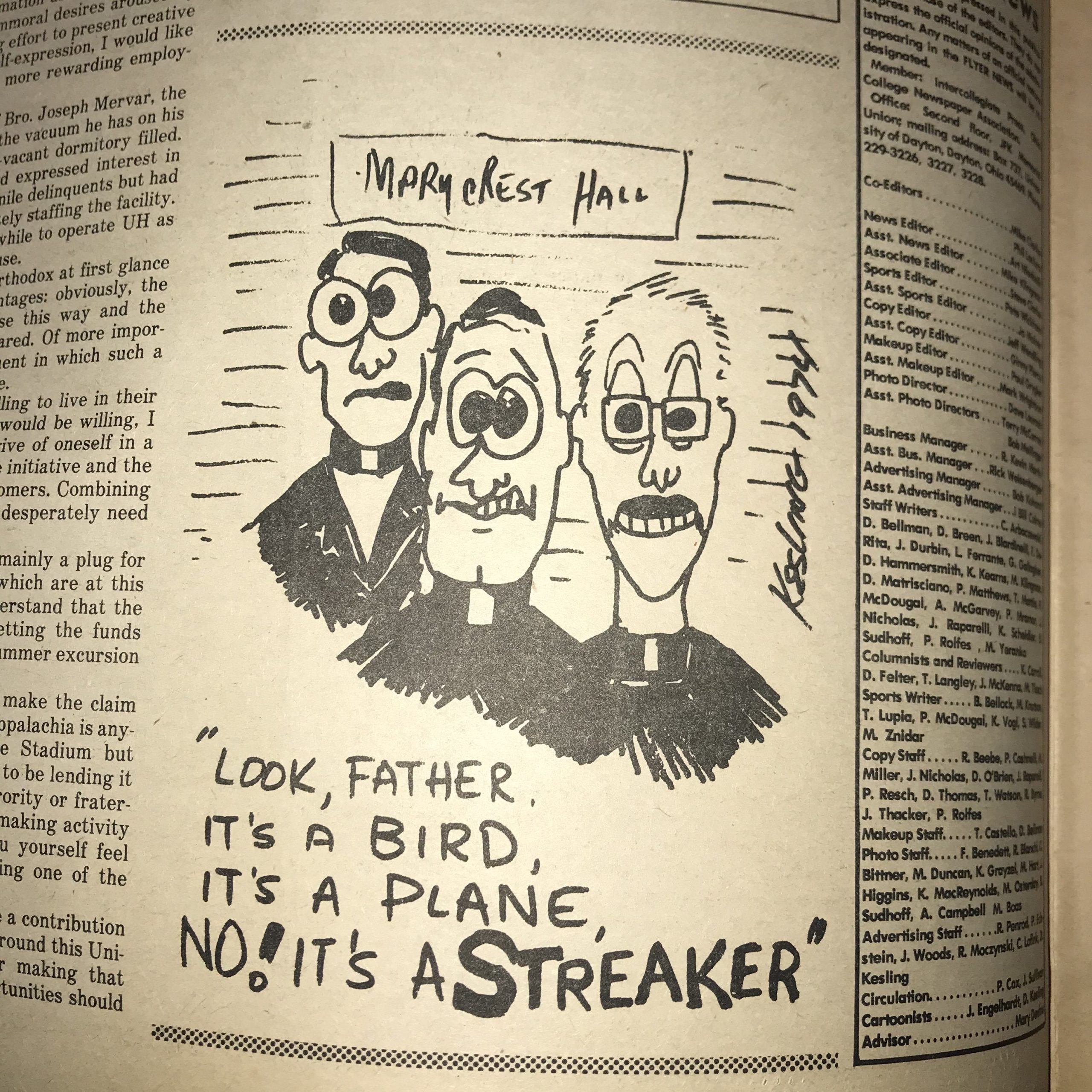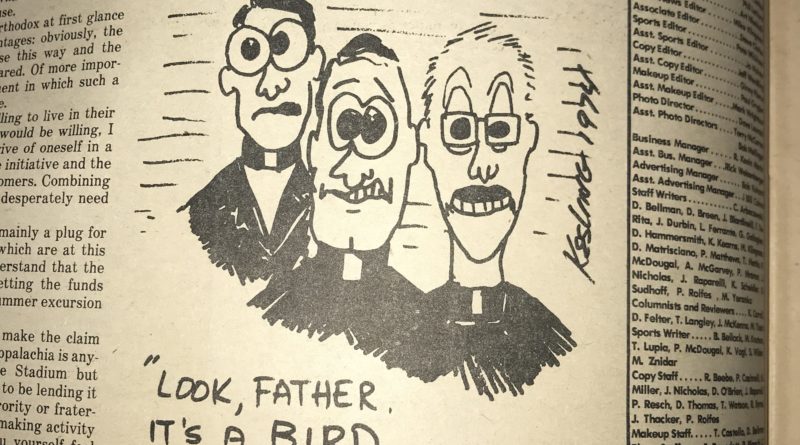From the archives: Flyer News coverage of recurrent streaking at UD in 1974
Garrett Reese
Archives Columnist
Editor’s note: This article details streaking, which is a criminal offense, on campus in the 70s. Specifically, there is one incident that is discussed that likely was sexual misconduct.
The last two adventures into UD’s Archive and the old issues of the Flyer News have been on two serious topics – the terrorist attacks on Sept. 11 and Watergate and the Nixon Presidency.
I figured it was time for a more light-hearted subject. Luckily, something caught my eye while researching Flyer News’ coverage of the student reactions to Watergate and Nixon.
On March 5, 1974, underneath a bright full moon, Flyer News reported on six separate instances of streaking on the University of Dayton campus.
It was not the headline ‘Nudist craze hits campus’ that caught my eye while flipping through the old, yellowing copies of Flyer News, but the picture that accompanied the article.
The black-and-white photo showed a figure throwing what appears to be a coat or jacket over their face to obscure their identity. Their backside, however, was left exposed for a Flyer News photographer’s camera to capture.
Editor’s note: Standards have changed since the 70s, so we will not be including the nude photo that was included in the March 1974 print edition in this article.
According to the article, published in the March 8 edition of the Flyer News, the streaking was clustered around Marycrest and Founders.
It occurred at Marycrest, which was only for female students at the time, from around 12:30 a.m. to 2:30 a.m. and at Founders, which was all-male, between 1 a.m. to 2 a.m.
One of the instances of streaking involved a group of young men clad only in long Army coats, which were quickly discarded as they ran past Marycrest and the ROTC building bare to the world.
One girl, a second-year education major, said of the event, “It was terrible. At first I thought it was a rally.”
Another remarked that they thought it was some initiation for a fraternity before realizing it was just for laughs.
Another group of men decided to stand outside Marycrest and “[serenade] females watching from their windows, requesting undergarments,” as the article put it.
Some of these young women decided to acquiesce the men, tossing various articles of underwear to them.
One Marycrest resident, however, had a different gift for the men. She tossed a bundle of bound copies of Flyer News from her window and struck one young man on the head. Flyer News reported he was “stunned momentarily” but otherwise okay.
At Founders later that evening, a black 1967 Pontiac rolled up to the front of the building.
Two young women, clad only in underwear, were in the car. They proceeded to take off their bras, “hang their breasts out the window,” and called out to the men of Founders Hall.
An Arts and Science second-year reported that when crowds began to form around the car, the young women took off, “tooting their horn.”
The second-year also reported seeing a girl undressing behind the ROTC building until a group of young men began to chase her, and she took off back toward the safety of Marycrest.
This sentence was reported with a casual tone that I found a tad unnerving. While the article made it appear that this was a fun event that didn’t cause any harm, this eyewitness account suggests otherwise.
Timothy Fenlon, who was director of campus security at the time, said that any streaker who was caught would be charged, depending on the situation. But he said a definite policy would be put in place if streaking were to become more frequent.
Unfortunately for Fenlon and campus security, it would become a commonplace event.
On the front page of the March 12, 1974 issue of Flyer News, a headline declares the charge Fenlon had decided on: “Campus Police to consider streaking indecent exposure.”

The tone of the previous article had been light and jovial, discussing a matter that many, though not all, thought was a humorous situation.
That feeling was gone in this new article. Fenlon reported that any streaker caught would be arrested and charged with a violation of the public indecency code.
Fenlon noted, however, that he was beginning to worry not just about the streaking but also about events that seemed to be following the streaking.
In one incident, an ambulance was blocked from getting up to Stuart Hill by a crowd that had come to witness a group of streakers being chased by a car.
One student, a first year, fell out of the car while it was chasing the streakers and was waiting on the ambulance to take him to St. Elizabeth’s Hospital (now known as the Medical Center at Elizabeth Place).
Another night, a student went as far as calling in a bomb threat at Marycrest in what Fenlon believed was an attempt to empty the building.
The women of Marycrest were becoming increasingly fed up with the streaking, according to the Marycrest resident director Kathy Shea, who said that they were finding the incidents “offensive especially after Wednesday night.”
What happened Wednesday night?
At around midnight, approximately 350 people gathered on the front lawn of Marycrest to witness two men streak. The crowd of 350 people were predominantly male, according to Flyer News.
“I came here for a Catholic education,” one of the streakers is reported to have said, all the while striking various poses for photographers before adding, “It’s national streaking week,” as if that explained the strange display.
The two streakers would perform gymnastics and put on what the student journalist called a “burlesque type show.”
The crowd, apparently, was not impressed.
After Fenlon and campus security declared their intent to charge any streaker who was caught, streaking seemed to slowly fade from UD’s campus.
A few cartoons popped up in the Flyer News in the following weeks, but after the article declaring the potential charges, there were no more articles written about instances of streaking. For a few hectic weeks, however, it seemed to dominate campus nightlife.

This took place during a significant time of change on UD’s campus.
ROTC, which had been mandatory for first and second-year men, was now voluntary.
Marycrest would become a co-ed dorm a few months after this streaking craze, a move that many found shocking and indecent.
UD students, like many college students across the nation, were finding their voices and protesting injustices they saw in the world and at home.
It was not just at UD that streaking became a fad – incidences were being reported from across the country.
In this YouTube video from WFAA, the ABC affiliate in Dallas, a glimpse into the year 1974 and the streaking fad that hit Southern Methodist University shows that streaking was captivating the minds of college students nationwide.
Beyond the world of college campuses, there is one notable instance of streaking that the entire nation got to see together while sitting comfortably at home.
During the 46th Academy Awards in April 1974, Robert Opal attempted to steal the show by running across the stage naked, flashing the crowd literally but also flashing a peace sign in a very 1970s move.
The host of the Awards quipped, “Just think, the only laugh that man will ever get in his life is by stripping off his clothes and showing his shortcomings.”
By years end, the streaking fad had largely faded from college campuses, but it still continues on at the University of North Carolina at Chapel Hill.
Students annually gather at the campus library, Davis Library, to witness a mass streaking of their peers.
The ritual began during the 1974 fad but has continued on and become a tradition on the southern campus.
According to an article by The Daily Tar Heel, UNC’s student newspaper, the tradition was cemented in 1977 for one reason – to honor finals.
It is for that reason the tradition continues on.
While streaking was something that delighted and entertained students across UD, Flyer News reporting shows other students found it distressing and deeply inappropriate.
Perhaps streaking was just another, albeit strange, attempt to push the boundaries of change that were going on around the country and on campus.
While earning a few laughs, a UD student could also push back against authority.
All it took was removing a few articles of clothing and running as fast as possible.
For more local & U.S. news like Flyer News on Facebook and follow us on Twitter (@FlyerNews) and Instagram (@flyernews)

